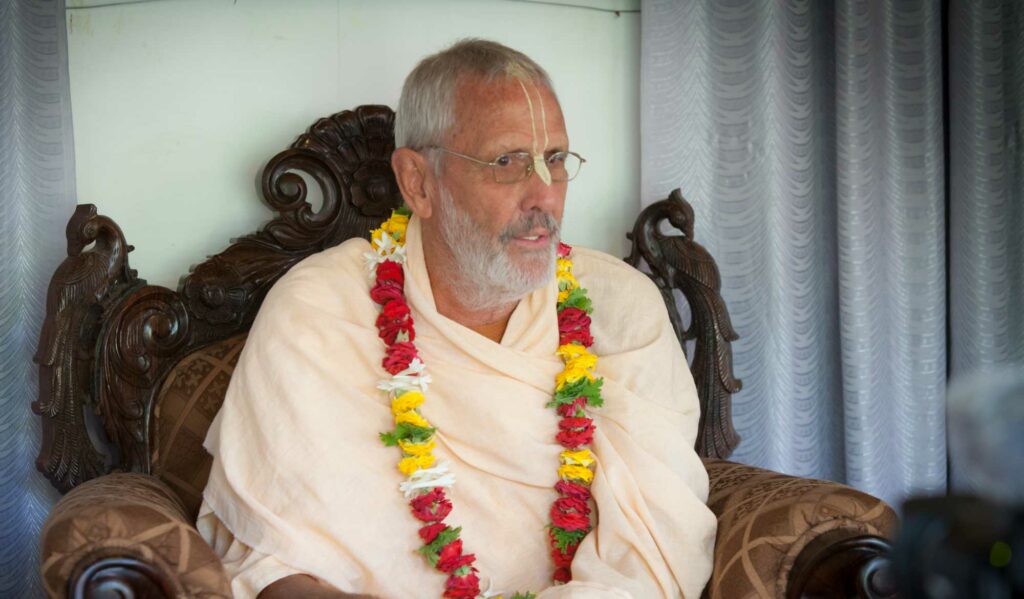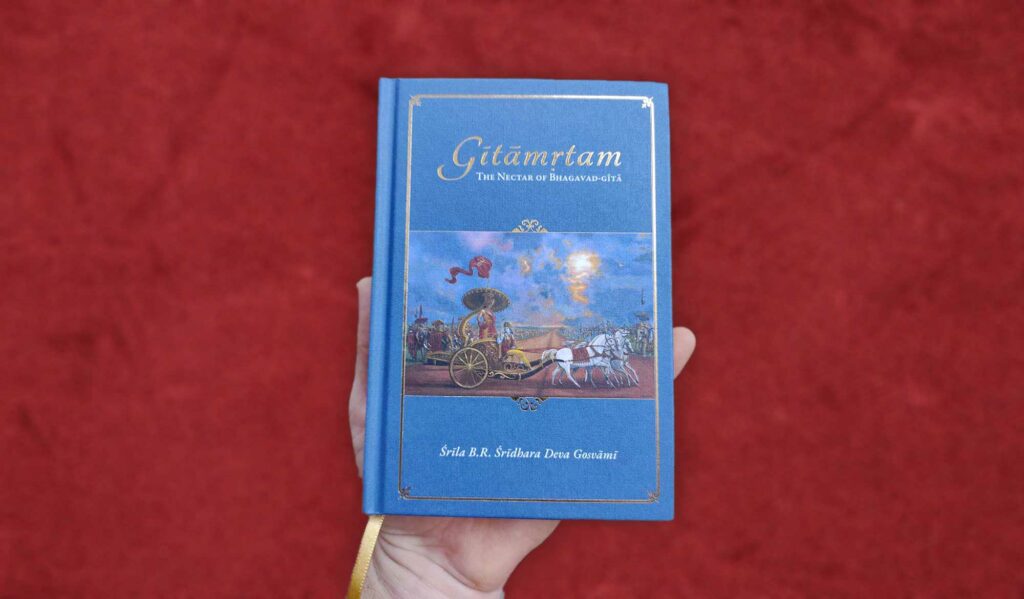Overview
Markaṭa Vairāgī (‘Monkey Renunciates’) was first published in Sajjana Toṣaṇī, Vol.8, Issue 10 in 1897. In this article, Śrīla Bhaktivinoda Ṭhākura discusses Mahāprabhu’s instructions to Raghunātha Dāsa Gosvāmī as well as the two types of fake renunciates found in both the gṛhastha āśrama and the sannyāsa āśrama.
When Śrī Śrī Mahāprabhu accepted sannyāsa and came to Śāntipura, then Raghunātha Dāsa, the son of Govardhana Majumdar, came and fell at the Lord’s feet. After staying close to the Lord’s feet for five to seven days, he returned home as per the Lord’s instruction. Being most distressed, he desired to go to Nīlācala, but his mother and father did not let him go. Again, when the Lord came to Śāntipura, he took permission from his mother and father and came to the feet of the Lord, praying to be free from his household bonds. Then the Lord taught him this:
sthira hañā ghare yāo, nā hao vātula
krame krame pāya loka bhava-sindhu-kūla
markaṭa-vairāgya nā kara loka dekhāñā
yathā-yogya viṣaya bhuñja anāsakta hañā
antare niṣṭhā kara, bāhye loka-vyavahāra
acirāt kṛṣṇa tomāya karibe uddhāra
“Be patient and return home. Do not be a madman. Gradually you will be able to cross the ocean of material existence. Do not show off to the public by becoming a monkey-like renunciate. For now, enjoy things in a proper way, but do not become attached to them. Develop determination internally, but externally behave like an ordinary man. Very soon Kṛṣṇa will liberate you.” (Caitanya-caritāmṛta, Madhya–līlā 16.235-237)
Again, in the sixth chapter of the Caritāmṛta it is written:
prabhura śikṣāte teṅho nija-ghare yāya
markaṭa-vairāgya chāḍi hailā viṣayi-prāya
bhitare vairāgya bāhire kare sarva-karma
dekhiyā ta’ mātā-pitāra ānandita mana
“According to the Lord’s instruction, Raghunātha Dāsa returned home, and giving up his markaṭa-vairāgya, he became almost a materialist. Internally he was renounced and externally he performed all activities. Seeing this, the minds of his mother and father were happy.” (Caitanya-caritāmṛta, Antya-līlā 6.15)
In relation to Choṭa Haridāsa, it is written in the Second Chapter of Śrī Caritāmṛta:
prabhu kahe vairāgī kare prakṛti sambhāṣaṇa
dekhite nā pāroṅ āmi tāhāra vadana
durvāra indriya kare viṣaya-grahaṇa
dāravī prakṛti hare munerapi mana
“The Lord said – I cannot look at the face of a renunciate who converses with women. The senses are so strong that they desire to accept the objects of the senses. Even the mind of a muni is attracted to the wooden form of a woman.” (Caitanya-caritāmṛta, Antya-līlā 2.117-118)
kṣudra-jīva saba markaṭa-vairāgya kariyā
indriya carāñā bule prakṛti sambhāṣiyā
“There are insignificant jīvas who engage in markaṭa-vairāgya. They wander around chatting with women.” (Caitanya-caritāmṛta, Antya-līlā 2.120)
prabhu kahe mora vaśa nahe mora mana
prakṛti-sambhāṣī vairāgī nā kare darśana
“The Lord said – My mind is not under My control! It refuses to see a renunciate who speaks with women.” (Caitanya-caritāmṛta, Antya-līlā 2.124)
In all these verses, the phrase ‘markaṭa-vairāgī’ is used. It is the duty of all to inquire what is the true meaning of the phrase markaṭa–vairāgī. Being a markaṭa–vairāgī is a particular offence, there is no doubt about this. It is easy to understand how offensive they are since the Lord refuses to see or touch them. The merciful Lord has descended in Kali-yuga to deliver the fallen, so all conscientious persons can understand how base and depraved such a person is if He is denying them. Thus, those who believe in Vaiṣṇava dharma should be very careful to avoid the company of markaṭa–vairāgīs and be cautious of becoming markaṭa–vairāgīs themselves.
It is not only those who leave their homes and take up sannyāsa that become markaṭa–vairāgīs. There are many amongst householders also. Therefore there are two types of markaṭa–vairāgīs i.e. the householder markaṭa–vairāgī and the non-householder markaṭa–vairāgī. When Dāsa Gosvāmī was a householder, then Mahāprabhu gave advice about the householder markaṭa–vairāgī. When giving instructions about Choṭa Haridāsa, He indicated the markaṭa–vairāgīs in the bhikṣu–āśrama (renounced order). We should now observe – what are the characteristics of the markaṭa–vairāgī amongst the householders and what are the characteristics of the markaṭa–vairāgī amongst those who have renounced their home?
First let us talk about the householder markaṭa-vairāgī. It is found within the words of Śrī Mahāprabhu that among the householders, those who are anxious to leave home unnecessarily are atyācārīs (negligent of their duties). Until the time and qualification are proper, no householder can go and join the bhikṣu-āśrama. All those householders who feign a display of possessing a mood of renunciation are wicked.
To enjoy household affairs without attachment is the dharma of a householder-Vaiṣṇava, Just as there is a decline in one’s Vaiṣṇava qualities when one is attached to sense-enjoyment, there is also a similar decline when one engages in bhoga-tyāga – abandoning one’s home or remaining at home for no reason. It is necessary for a householder to experience detachment to the objects of the senses in order to possess the qualification to leave home.
External renunciation is extremely contaminating for a householder. Externally enjoying material things accordingly and cultivating internal dispassion is the dharma of a householder. When firm renunciation is in full force, then that is the time and qualification to leave home. All those householders who carry the burden of wearing kaupīna and having dreadlocks are called markaṭa-vairāgīs. He who is married with a wife is a householder. Sannyāsa is the name given to renouncing one’s wife after vowing to observe dharma and virtue. When renunciation has not completely filled the heart, one has no eligibility to follow it. When there is such a strong attachment to kṛṣṇa-kathā that there is no taste or chance to enjoy other material objects, then the qualification for renunciation is born. It is from attachment to Kṛṣṇa that a natural distaste for other things arises. Inner renunciation cannot come from anything else. The distrust in material things that arises through the practice of viveka (discrimination) and other such causes is not permanent. But dispassion born from bhakti remains in the heart. According to the Dharma Śāstra, those who are legally married are without sin. Inter-caste marriages are not according to śāstra and one does not achieve the dharma of a householder from that. Fallen yogīs or those connected with them cannot be called householders. Gṛhastha–dharma is based upon varṇāśrama. Intercourse amongst antyajas (outcastes) is merely a careless use of the senses to a certain extent. If householders desire to become Vaiṣṇavas, they should be especially careful to give up markaṭa–vairāgya.
Therefore the instructions to Śrī Dāsa Gosvāmī by Śrī Mahāprabhu are of a character to give advice to people about the good character of a householder Vaiṣṇava. Due to the teachings of the Lord, he went home, gave up the previous characteristics of markaṭa-vairāgya and made efforts to enjoy material things. The meaning of this is that despite outwardly accepting all material activities, he began to nurture dispassion inwardly. The meaning of the phrase viṣayi-prāya (almost a sense-enjoyer) is that although he accepted material things such as clothes, activities, behaviour etc., within his heart, he did not enjoy them.
The Lord referred to Dāsa Gosvāmī’s father as vaiṣṇava-prāya (almost a Vaiṣṇava). This means that despite his accepting vaiṣṇava-dīkṣā, possessing the external characteristics of a Vaiṣṇava, worshipping the Devas, following vratas, going on pilgrimage, and showing hospitality to guests, in his heart he was a sense-enjoyer. It is preferable to be a sense-enjoyer than a vaiṣṇava–prāya. If a person who is a vaisnava–prāya does not try to elevate his wife in the association of sādhus, he can also be classified as a markaṭa-vairāgī. Wearing the garb of a sannyāsī, introducing oneself as a renunciate, endeavouring to perform excessive detachment, or identifying with the external signs of a Vaiṣṇava – all this is markaṭa–vairāgya for a householder. All these are against the instructions of Mahāprabhu and is opposed to proper conduct. Those who engage in arthavāda (speculative interpretations) to support all sorts of sense-gratification are also in that category.
Now let us deliberate upon how many forms of markaṭa–vairāgya there are amongst those persons who have renounced their homes. A householder who abandons his household dharma before natural renunciation has fully manifest due to the emergence of bhakti, is likely to develop markaṭa-vairāgya. The enjoying tendency has not left him. The influence of temporary renunciation will subside. The instinct to converse and associate with women gradually becomes stronger and great depravity ensues. No matter how much bhakti is there, there will be a delay in the removal of that desire.
Choṭa Haridāsa left his body and attained Gandharvaloka. That is the nature of bhakti. In whichever heart she arises, she destroys any anartha at the root which is residing there. After experiencing all the pleasures of puṇya, renunciation eventually manifests. In that position, devotees who maintain some material desires experience the pleasures of that world. All pāpa within their hearts is eventually burned. In this way, Choṭa Haridāsa who had a desire to associate with women, attained a planet where he could fulfill his desire and Bhakti Devī would gradually award him with renunciation.
Despite what the Lord said about Haridāsa, for the community of Vaiṣṇavas who have renounced their homes, he is a markaṭa-vairāgī. The Lord says that a person who has accepted sannyāsa which has been witnessed by the people and by dharma, can no longer associate with women. Even if he intends to perform some proper or righteous action, it is not appropriate for him to speak to a woman. If a renunciate keeps a maid in his ākhaḍā (monastery) or kuñja on the pretext of her washing the plates of the Deity, according to the Lord, he is also a markaṭa–vairāgī.
The Lord said, “I cannot see the face of a renunciate who violates his own position and dharma by conversing with a woman. In other words, I cannot keep him in My pure Vaiṣṇava sampradāya. Although a renunciate may be strict, there is still a possibility that he will become degraded by conversing with women. All the senses are naturally weak and they are always greedy for their own objects. Therefore a renunciate will always take special care to stay away from gazing at women. Look, even the mind of a muni becomes restless if he sees the form of a woman made of wood.”
At this point, it can also be concluded that if a renunciate watches a woman in a theatre and observes her gestures, he undoubtedly behaves like a markaṭa-vairāgī. Any renunciate who indulges in listening to dramas or goes to the theatre is at fault. He is an insignificant jīva, i.e. one who has weakness of heart (hṛdaya-daurbalyā) yet he carries the marks of a renunciate. In other words, by conversing with women he is allowing his senses to wander. The markaṭa-vairāgīs who visit women in the name of begging or mādhukarī, all the renunciates who talk with women under the pretext of collecting alms can never remain or take a position in the sampradāya of Mahāprabhu. When the other Vaiṣṇavas petitioned on behalf of Haridāsa, the Lord said, “I cannot in any way keep a renunciate who associates with women near Me because I do not want to even touch him. So why are you requesting Me? My mind is not My own. I do not wish to see a markaṭa-vairāgī nor do I wish to touch his body!”
Alas! Where do these words of chastisement from the pure character of Lord Gauracandra now remain! Due to the influence of Kali, there is a prevalence of Vaiṣṇavas that are both markaṭa–gṛhasthas and vairāgīs who are a blight on this pure sampradāya. How many householder Vaiṣṇavas are attempting to save themselves from their own wrongdoings by assuming the false signs of renunciation. If true renunciation exists in them, then they may leave their home forever, wear a kaupīna and remain with their guru. Moreover, they should not converse with women. If the tendency to associate with women remains anywhere in the heart, then they should not accept the garb of a renunciate. Always elevate the ātmā through sādhana and always feel the bliss of kṛṣna-nāma, and markaṭa-vairāgya will be removed. There is no necessity to busy oneself in accepting renunciation prematurely.
Both householders and renunciates are eligible for kṛṣṇa-bhakti. What are the benefits derived from an āśrama? Let us consider. It cannot be said that all persons are qualified to be in an āśrama. Most people are eligible for the gṛhastha-āśrama. Less people are qualified for the vairāgya, vānaprastha and brahmacārī āśramas. What is at the basis to attain qualification for those āśramas? Is it age or nature? Age alone cannot be said to be the basis. Many old men are crawling within their minds. They are indeed old. There are no teeth, all their hairs have gone grey, but using hair dye and adding silver teeth, they remain busy in enjoyment just like a young boy. When all those old people do not have detachment, then age cannot be said to be the main cause of renunciation. As long as enjoyment or the desire for material things stays in the heart, then the natural disposition of a gṛhastha will remain strong. However, when bhāva for Bhagavān arises in the heart, there will be a natural feeling of disgust towards sense-objects – that nature is at the root of the vairāgya-āśrama.
Whether a man possesses the nature of a householder or he achieves the nature of renunciation, bhakti is his wealth. That wealth of bhakti is wisdom, or whatever activity or conduct is favourable to bhakti. Bhakti is the cultivation of serving Kṛṣṇa favourably. Therefore, for one whose household dharma is conducive for the cultivation of serving Kṛṣṇa, household dharma is better. And for one whom the vairāgya-āśrama is favourable for the cultivation of serving Kṛṣṇa, for him renunciation is better. Anarthas increase and bhakti decreases due to a neglect of proper qualification. Thus, if one is able to give up markaṭa-vairāgya, the excellence of bhakti arises for both the householder and the renunciate.
The anarthas of the jīva are of four kinds:
1) svarūpa-bhrama (misconceptions concerning one’s intrinsic nature)
2) asat-tṛṣṇa (the thirst for material things)
3) aparādha (offences)
4) hṛdaya-daurbalyā (weakness of heart)
By engaging in bhajana, if these four kinds of anarthas are removed, then one’s bhajana becomes stable. Markaṭa-vairāgya is primarily hṛdaya-daurbalyā. If this is removed then potency arises in one’s bhajana. The staunch enemies of the jīva such as hypocrisy, wickedness, the desire for prestige etc. are defeated and pure bhakti manifests and the jīva achieves success.
Related Articles & Books
- 📖 The Meaning of the Sannyāsa Āśrama (Book)
- Markaṭa Vairāgī (Monkey Renunciates) by Śrīla Bhaktivinoda Ṭhākura
- Tridaṇḍi by Śrīla Bhaktisiddhānta Sarasvatī Ṭhākura
- The Colour for Sannyāsīs by Śrīla Bhakti Gaurava Narasiṅgha Mahārāja
- Bābājī Sannyāsa by Śrīla Bhakti Gaurava Narasiṅgha Mahārāja
- Sannyāsa Re-initiation by Śrīla Bhakti Gaurava Narasiṅgha Mahārāja
- Is Sannyāsa Forbidden in Kali-yuga? Swami B.V. Giri
- Parātma-niṣṭhā by Swami B.V. Giri
- Vairāgya (Renunciation) by Śrīla Bhaktivinoda Ṭhākura
- Bhek Dhāraṇa (Accepting the Dress of a Bābājī) by Śrīla Bhaktivinoda Ṭhākura
- Brahmacārī Āśrama by Śrīla Bhaktivinoda Ṭhākura
Further Reading
Pilgrimage with Swami Narasiṅgha – Part 7: Keśī Ghāṭa
Continuing with our pilgrimage series, this week Śrīla Narasiṅgha Mahārāja takes us to Keśī Ghāṭā where he tells us about Madhumaṅgala’s meeting with the Keśī demon, what Keśī represents, and how Śrīla Prabhupāda almost acquired Keśī Ghāṭa. Mahārāja also narrates his own experience. This article has been adapted from a number of talks and articles by Narasiṅgha Mahārāja.
Prema Dhāma Deva Stotram with the Narasiṅgha Sevaka Commentary – Verses 61-65
In verses 61 to 65 of 'Prema Dhāma Deva Stotram', Śrīla Śrīdhara Mahārāja narrates the pastime of Śrī Caitanya at Caṭaka Parvata In Purī and explains how the scriptures produced by Brahmā and Śiva are ultimately searching for the personality of Mahāprabhu who is merciful too all jīvas, no matter what their social position.
Prabhupāda Śrīla Sarasvatī Ṭhākura’s Visit to Ayodhyā
With the forthcoming observance of Śrī Rāma Navamī, we present 'Prabhupāda Śrīla Sarasvatī Ṭhākura’s Visit to Ayodhyā' written by Śrīla Bhaktisiddhānta Sarasvatī Ṭhākura Prabhupāda from The Gaudīyā magazine, Vol 3. Issue 21/ In December 1924, after visiting Benares and Prāyāga, Sarasvatī Ṭhākura visited the birth-site of Śrī Rāmācandra in Ayodhyā.
Śaraṇāgati – The Only Path to Auspiciousness
In this article, 'Śaraṇāgati - The Only Path to Auspiciousness', Dhīra Lalitā Dāsī analyses the process of śaraṇāgati (surrender) beginning with śraddhā (faith). She also discusses the role of śāstra and the Vaiṣṇava in connection with surrender.
Pilgrimage with Swami Narasiṅgha – Part 7: Keśī Ghāṭa
Continuing with our pilgrimage series, this week Śrīla Narasiṅgha Mahārāja takes us to Keśī Ghāṭā where he tells us about Madhumaṅgala’s meeting with the Keśī demon, what Keśī represents, and how Śrīla Prabhupāda almost acquired Keśī Ghāṭa. Mahārāja also narrates his own experience. This article has been adapted from a number of talks and articles by Narasiṅgha Mahārāja.
Prema Dhāma Deva Stotram with the Narasiṅgha Sevaka Commentary – Verses 61-65
In verses 61 to 65 of 'Prema Dhāma Deva Stotram', Śrīla Śrīdhara Mahārāja narrates the pastime of Śrī Caitanya at Caṭaka Parvata In Purī and explains how the scriptures produced by Brahmā and Śiva are ultimately searching for the personality of Mahāprabhu who is merciful too all jīvas, no matter what their social position.
Prabhupāda Śrīla Sarasvatī Ṭhākura’s Visit to Ayodhyā
With the forthcoming observance of Śrī Rāma Navamī, we present 'Prabhupāda Śrīla Sarasvatī Ṭhākura’s Visit to Ayodhyā' written by Śrīla Bhaktisiddhānta Sarasvatī Ṭhākura Prabhupāda from The Gaudīyā magazine, Vol 3. Issue 21/ In December 1924, after visiting Benares and Prāyāga, Sarasvatī Ṭhākura visited the birth-site of Śrī Rāmācandra in Ayodhyā.
Śaraṇāgati – The Only Path to Auspiciousness
In this article, 'Śaraṇāgati - The Only Path to Auspiciousness', Dhīra Lalitā Dāsī analyses the process of śaraṇāgati (surrender) beginning with śraddhā (faith). She also discusses the role of śāstra and the Vaiṣṇava in connection with surrender.








